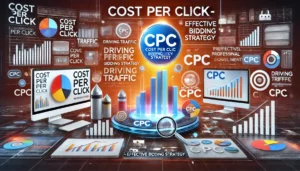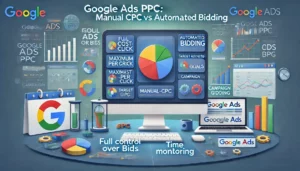Mastering Online Advertising: Choosing the Right Bidding Strategy (CPC, CPA, ROAS) for Maximum ROI

Choosing the Right Bidding Strategy: in the world of online advertising, picking the right bidding strategy is key to making the most of your budget. Whether you’re using CPC, CPA, or ROAS, each approach has its own benefits and can help you reach your goals. This guide will walk you through the basics and help you choose the best strategy for your campaigns.
Key Takeaways
- Understanding different bidding strategies like CPC, CPA, and ROAS can help you optimise your ad spend.
- Choosing the right strategy depends on your campaign goals and target audience.
- Manual and automated bidding options each have their own pros and cons.
- Platforms like Google Ads and Facebook Ads offer various tools to help you manage your bids.
- Regularly reviewing and adjusting your bids can lead to better performance and higher ROI.
Understanding the Basics of CPC, CPA, and ROAS
Defining Cost Per Click (CPC)
Cost Per Click (CPC) is a common bidding strategy in online advertising. With CPC, you pay each time someone clicks on your ad. This method is ideal for driving traffic to your website. It’s crucial to monitor your CPC to ensure you’re not overspending. A well-managed CPC campaign can be highly effective, especially when handled by a professional PPC agency.
Explaining Cost Per Acquisition (CPA)
Cost Per Acquisition (CPA) focuses on the cost of acquiring a customer. This strategy is perfect for campaigns with clear conversion goals, like sign-ups or purchases. By setting a target CPA, you can control how much you’re willing to pay for each conversion. This method is often used in PPC management to optimise ad spend and improve ROI.
Understanding Return on Ad Spend (ROAS)
Return on Ad Spend (ROAS) measures the revenue generated for every dollar spent on advertising. This metric is essential for campaigns aimed at maximising revenue. A high ROAS indicates that your ads are performing well and generating significant returns. Regular PPC audits can help you maintain a healthy ROAS by identifying areas for improvement.
In online advertising, choosing the right bidding strategy can significantly impact your campaign’s success. Whether you opt for CPC, CPA, or ROAS, understanding these basics will help you make informed decisions and achieve your marketing goals.
Choosing the Right Bidding Strategy for Your Campaign
Factors to Consider When Selecting a Strategy
Choosing the right bidding strategy for your campaign depends on several key factors. Your campaign goals should be the primary driver of your decision. Are you aiming for more clicks, conversions, or a specific return on ad spend? Next, consider your budget. A limited budget might require a more conservative approach, while a larger budget allows for more aggressive strategies. Also, evaluate the performance of your existing campaigns. If certain strategies have worked well in the past, they might be worth continuing. Lastly, think about the competitiveness of your target keywords. Highly competitive keywords may need a higher bid to achieve desired results.
Aligning Bidding Strategies with Campaign Goals
Aligning your bidding strategy with your campaign goals is crucial. For instance, if your goal is to drive traffic to your website, a Cost Per Click (CPC) strategy might be ideal. On the other hand, if you aim to increase conversions, a Cost Per Acquisition (CPA) strategy could be more effective. For those looking to maximise revenue, focusing on Return on Ad Spend (ROAS) is essential. Each strategy has its strengths and should be chosen based on what you want to achieve.
Examples of Successful Bidding Strategies
Here are some examples of successful bidding strategies:
- E-commerce Store: An online store aiming to maximise sales might use a Target ROAS strategy to ensure they get the most revenue for their ad spend.
- Lead Generation: A company focused on generating leads might opt for a Target CPA strategy to control costs while acquiring new customers.
- Brand Awareness: A business looking to increase brand visibility might choose a Manual CPC strategy to get more clicks and impressions.
Choosing the right bidding strategy can significantly impact your campaign’s success. Take the time to evaluate your goals, budget, and past performance to make an informed decision.
Leveraging Google Ads Bidding Strategies
Manual CPC vs. Automated Bidding
When it comes to Google ads PPC, you have two main options: Manual CPC and Automated Bidding. Manual CPC gives you full control over your bids, allowing you to set the maximum cost-per-click for your ads. This can be beneficial if you have a clear understanding of your target audience and campaign goals. However, it can be time-consuming and requires constant monitoring.
On the other hand, Automated Bidding uses advanced machine learning to optimise your bids in real-time. This method can save you time and potentially increase your ROI by adjusting bids based on various factors like device, location, and user behaviour. Automated Bidding is ideal for those who want to leverage data-driven insights without the hassle of manual adjustments.
Using Target CPA for Conversion Optimisation
Target CPA (Cost Per Acquisition) is a smart bidding strategy that focuses on getting as many conversions as possible at your target cost per acquisition. This is particularly useful for eCommerce PPC campaigns where the goal is to maximise sales. By setting a target CPA, Google Ads will automatically adjust your bids to help you achieve this goal. This strategy is highly effective for businesses looking to optimise their conversion rates without overspending.
Maximising ROI with Target ROAS
Target ROAS (Return on Ad Spend) is another powerful bidding strategy offered by Google Adwords PPC. This strategy aims to maximise the revenue you earn from your ad spend. By setting a target ROAS, Google Ads will automatically adjust your bids to achieve the desired return on ad spend. This is particularly useful for businesses that have a clear understanding of their profit margins and want to ensure that their advertising efforts are profitable.
Leveraging the right bidding strategy can make a significant difference in your campaign’s success. Whether you choose Manual CPC, Target CPA, or Target ROAS, it’s crucial to align your strategy with your business goals and continuously monitor performance.
For those who find it challenging to manage their campaigns, partnering with a London PPC agency or other Google ads agencies can provide the expertise needed to optimise your campaigns effectively. Regular Google ads audits can also help identify areas for improvement and ensure that your campaigns are running smoothly.
Optimising Facebook Ads with Effective Bidding
Cost-Per-Click (CPC) vs. Cost-Per-Action (CPA)
Choosing between CPC and CPA bidding on Facebook depends on your campaign goals. CPC is ideal for driving traffic to your website, while CPA focuses on specific actions like sign-ups or purchases. Evaluate your objectives to determine which strategy aligns best with your needs.
Utilising Facebook’s Automatic Bidding
Facebook’s automatic bidding feature helps you optimise your budget by adjusting bids in real-time. This tool considers various factors, such as user behaviour and competition, to ensure your ads reach the right audience at the best price. Automatic bidding can save time and improve efficiency.
Best Practices for Facebook Ad Bidding
To get the most out of your Facebook ad campaigns, follow these best practices:
- Regularly monitor performance metrics like click-through rates and conversion rates.
- Conduct A/B tests to compare different bidding strategies and ad creatives.
- Adjust your bids based on performance data to maximise ROI.
By consistently analysing data and refining your bidding strategy, you can achieve better results and drive successful outcomes.
The Impact of Bidding on Ad Placement and Performance
Bidding in digital marketing is crucial for determining where your ads appear. Advertisers compete in real-time auctions, and the amount you bid can significantly influence your ad’s placement. Higher bids often lead to better ad positions, meaning your ads are more likely to be seen by potential customers. This increased visibility can result in higher click-through rates (CTR) and more conversions.
To optimise your bidding strategy, you need to keep an eye on key performance metrics. These include CTR, conversion rates, and return on ad spend (ROAS). By monitoring these metrics, you can adjust your bids to improve your campaign’s effectiveness. Constantly reviewing and tweaking your bids based on performance data is essential for maximising ROI.
Once you have gathered enough performance data, it’s time to make informed adjustments to your bids. If a particular keyword or ad group is performing well, consider increasing your bid to capitalize on its success. Conversely, if something isn’t working, don’t hesitate to lower your bid or pause the campaign. This ongoing optimisation process helps ensure that your advertising budget is spent wisely and effectively.
Strategic bidding not only improves ad placement but also enhances the overall success of your digital marketing efforts.
The Role of Machine Learning in Automated Bidding
Machine learning is transforming the way we approach online advertising. By analysing vast amounts of data, machine learning algorithms can make real-time decisions that optimise your bids. This technology considers factors like user behaviour, historical performance, and contextual signals to determine the best bid amounts.
One of the main advantages of using machine learning in bidding is its ability to process and analyse data far beyond human capability. This leads to more accurate and efficient bidding decisions. Additionally, machine learning can adapt to changes in user behaviour and market conditions, ensuring your bids remain competitive.
Automated bidding strategies, such as Target CPA and Target ROAS, leverage machine learning to optimise bids for each auction. These strategies analyse a multitude of factors to make informed decisions, helping you achieve your campaign goals more effectively. However, it’s important to note that these strategies require a significant amount of historical data to be effective, which can be a limitation for new campaigns.
A/B Testing to Refine Your Bidding Strategy
Setting Up A/B Tests for Bidding
A/B testing, also known as split testing, is a powerful method to compare two versions of an ad campaign. This helps you see which one performs better. Start by setting clear goals for what you want to test, such as different bid amounts or strategies. Make sure to run these tests either in parallel or sequentially to get accurate results.
Analysing A/B Test Results
Once your tests are complete, it’s time to dive into the data. Look at key metrics like click-through rate (CTR), conversion rate, cost per conversion, and overall ROI. Evaluating these metrics will help you understand which strategy is more effective. Use this data to make informed decisions about your bidding strategy.
Implementing Changes Based on A/B Testing
After analysing the results, implement the changes that showed the best performance. This might mean adjusting your bid amounts or switching to a different bidding strategy altogether. Keep monitoring the performance to ensure that the changes are delivering the expected results.
Regularly conducting A/B tests and making data-driven adjustments can significantly improve your ad campaign’s performance and ROI.
Conclusion
Choosing the right bidding strategy is key to making the most out of your online advertising budget. Whether you go with CPC, CPA, or ROAS, each has its own strengths and can be tailored to meet your specific goals. By understanding how each strategy works and regularly reviewing your campaign’s performance, you can make smarter decisions that lead to better results. Remember, the world of online advertising is always changing, so stay flexible and keep learning to stay ahead of the game. With the right approach, you can maximise your ROI and achieve your marketing goals.
Frequently Asked Questions
What is Cost Per Click (CPC)?
Cost Per Click (CPC) is a bidding strategy where you pay each time someone clicks on your ad. It’s often used to drive traffic to your website.
How does Cost Per Acquisition (CPA) work?
Cost Per Acquisition (CPA) means you pay when someone takes a specific action, like making a purchase or signing up for a newsletter. It’s great for conversion-focused campaigns.
What does Return on Ad Spend (ROAS) mean?
Return on Ad Spend (ROAS) measures the revenue you earn for every dollar spent on advertising. It’s a key metric to understand the effectiveness of your ad campaigns.
Which bidding strategy should I choose for my campaign?
Choosing the right bidding strategy depends on your campaign goals. For example, use CPC for driving traffic, CPA for conversions, and ROAS for maximising revenue.
How can machine learning improve bidding strategies?
Machine learning can optimise bids in real-time by analysing data and predicting outcomes, making your campaigns more efficient and effective.
What is A/B testing and why is it important?
A/B testing involves running two versions of an ad to see which performs better. It’s important for refining your bidding strategy and improving overall campaign performance.
Author
Search Blog
Free PPC Audit
Subscribe to our Newsletter
The Voices of Our Success: Your Words, Our Pride
Don't just take our word for it. With over 100+ five-star reviews, we let our work-and our satisfied clients-speak for us.
"We have been working with PPC Geeks for around 6 months and have found Mark and the team to be very impressive. Having worked with a few companies in this and similar sectors, I rate PPC Geeks as the strongest I have come across. They have taken time to understand our business, our market and competitors and supported us to devise a strategy to generate business. I value the expertise Mark and his team provide and trust them to make the best recommendations for the long-term."
~ Just Go, Alasdair Anderson




